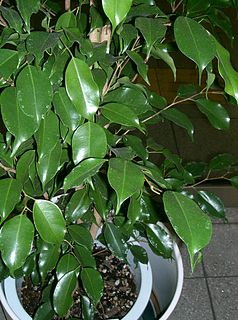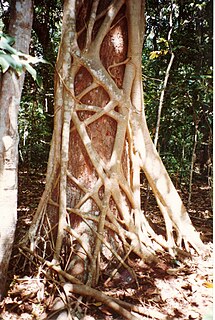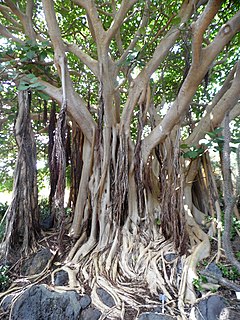
Ficus is a genus of about 850 species of woody trees, shrubs, vines, epiphytes and hemiepiphytes in the family Moraceae. Collectively known as fig trees or figs, they are native throughout the tropics with a few species extending into the semi-warm temperate zone. The common fig (F. carica) is a temperate species native to southwest Asia and the Mediterranean region, which has been widely cultivated from ancient times for its fruit, also referred to as figs. The fruit of most other species are also edible though they are usually of only local economic importance or eaten as bushfood. However, they are extremely important food resources for wildlife. Figs are also of considerable cultural importance throughout the tropics, both as objects of worship and for their many practical uses.

A banyan, also spelled "banian", is a fig that begins its life as an epiphyte, i.e. a plant that grows on another plant, when its seed germinates in a crack or crevice of a host tree or edifice. "Banyan" often specifically denominates Ficus benghalensis, which is the national tree of India, though the name has also been generalized to denominate all figs that share a common life cycle and used systematically in taxonomy to denominate the subgenus Urostigma.

Ficus benghalensis, commonly known as the banyan, banyan fig and Indian banyan, is a tree native to the Indian Subcontinent. Specimens in India are among the largest trees in the world by canopy coverage.

Ficus macrophylla, commonly known as the Moreton Bay fig or Australian banyan, is a large evergreen banyan tree of the family Moraceae native to eastern Australia, from the Wide Bay–Burnett region in the north to the Illawarra in New South Wales, as well as Lord Howe Island. Its common name is derived from Moreton Bay in Queensland, Australia. It is best known for its imposing buttress roots.

Ficus rubiginosa, the rusty fig or Port Jackson fig, is a species of flowering plant native to eastern Australia in the genus Ficus. Beginning as a seedling that grows on other plants (hemiepiphyte) or rocks (lithophyte), F. rubiginosa matures into a tree 30 m (100 ft) high and nearly as wide with a yellow-brown buttressed trunk. The leaves are oval and glossy green and measure from 4 to 19.3 cm long and 1.25 to 13.2 cm wide.

Ficus benjamina, commonly known as weeping fig, benjamin fig or ficus tree, and often sold in stores as just ficus, is a species of flowering plant in the family Moraceae, native to Asia and Australia. It is the official tree of Bangkok. A recently described variety, Ficus benjamina var. Bracteata is found in uplifted coral forests of southern Taiwan. The species is also naturalized in the West Indies and in the states of Florida and Arizona in the United States. In its native range, its small fruit are favored by some birds, such as the superb fruit dove, wompoo fruit dove, pink-spotted fruit dove, ornate fruit dove, orange-bellied fruit dove, Torresian imperial pigeon, and purple-tailed imperial pigeon.

Aerial roots are roots above the ground. They are almost always adventitious. They are found in diverse plant species, including epiphytes such as orchids (Orchidaceae), tropical coastal swamp trees such as mangroves, banyan figs, the warm-temperate rainforest rata and pohutukawa trees of New Zealand. Vines such as Common Ivy and poison ivy also have aerial roots.

Ficus microcarpa, also known as Chinese banyan, Malayan banyan, Indian laurel, curtain fig, or gajumaru (ガジュマル), is a tree in the fig family Moraceae. It is native in a range from China through tropical Asia and the Caroline Islands to Australia. It is widely planted as a shade tree and frequently misidentified as F. retusa or as F. nitida.

Strangler fig is the common name for a number of tropical and subtropical plant species, including some banyans and unrelated vines, including among many other species:

Ficus citrifolia, also known as the shortleaf fig, giant bearded fig, Jagüey, wild banyantree and Wimba tree, is a species of banyan native to southern Florida, the Caribbean, Mexico, Central America, and northern South America south to Paraguay. It is distinguished from the closely related Florida strangler fig mainly by the finer veining in the leaves.

Ficus elastica, the rubber fig, rubber bush, rubber tree, rubber plant, or Indian rubber bush, Indian rubber tree, is a species of plant in the fig genus, native to eastern parts of South Asia and southeast Asia. It has become naturalized in Sri Lanka, the West Indies, and the US State of Florida.

Ficus pumila, commonly known as the creeping fig or climbing fig, is a species of flowering plant in the mulberry family, native to East Asia and naturalized in parts of the southeastern and south-central United States. It is also found in cultivation as a houseplant. The Latin specific epithet pumila means "dwarf", and refers to the very small leaves of the plant.

Ceratocystis fimbriata is a fungus and a plant pathogen, attacking such diverse plants as the sweet potato and the tapping panels of the Para rubber tree. It is a diverse species that attacks a wide variety of annual and perennial plants. There are several host-specialized strains, some of which, such as Ceratocystis platani that attacks plane trees, are now described as distinct species.

Ficus aurea, commonly known as the Florida strangler fig, golden fig, or higuerón, is a tree in the family Moraceae that is native to the U.S. state of Florida, the northern and western Caribbean, southern Mexico and Central America south to Panama. The specific epithet aurea was applied by English botanist Thomas Nuttall who described the species in 1846.

Ficus insipida is a tropical tree in the fig genus of the family Moraceae. It ranges from Mexico to South America, and is commonly found in cloud forest above 1,550 m ASL.

Ficus obliqua, commonly known as the small-leaved fig, is a tree in the family Moraceae, native to eastern Australia, New Guinea, eastern Indonesia to Sulawesi and islands in the southwestern Pacific Ocean. Previously known for many years as Ficus eugenioides, it is a banyan of the genus Ficus, which contains around 750 species worldwide in warm climates, including the edible fig. Beginning life as a seedling, which grows on other plants (epiphyte) or on rocks (lithophyte), F. obliqua can grow to 60 m (200 ft) high and nearly as wide with a pale grey buttressed trunk, and glossy green leaves.

Ficus sur, with the common names Cape fig and broom cluster fig, is a widespread Afrotropical species of cauliflorous fig.

Ficus altissima, commonly known as the council tree and lofty fig, is a species of flowering plant, a fig tree in the family Moraceae. It is a large, stately evergreen hemiepiphyte and is native to southeastern Asia.

Ficus vasta is a fig plant found in Ethiopia and Yemen. The tree is a species of sycamore-fig.

Ficus exasperata, also called the sandpaper tree, forest sandpaper fig, white fig, or sandpaper leaf tree, is a deciduous, and dioecious species of plant in the mulberry family Moraceae, native to tropical Africa and southern Asia.



















